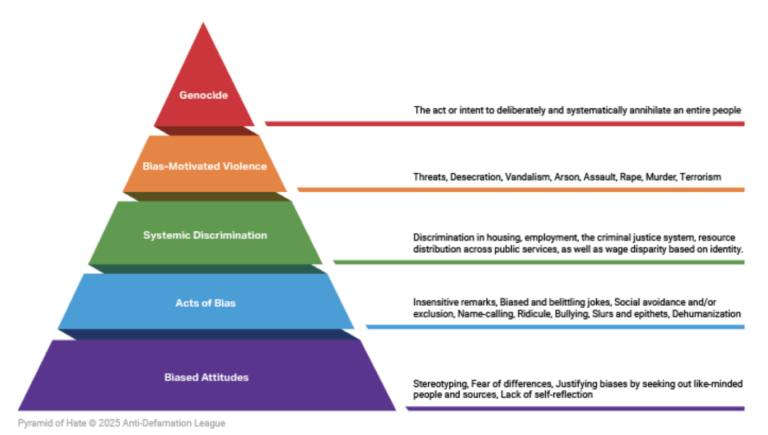Because every hatred starts with a word—and every alliance starts with a simple act.
In a world increasingly divided by “us vs. them” mentalities, building international peace is no longer optional—it’s essential.
The deeper we fall into labeling, othering, and suspicion, the harder it becomes to see one another as human. But here’s the hard question that peacebuilders, activists, and citizens must ask:
How do you stay human in front of someone who might want to kill you?
That’s not a metaphor. It’s the emotional weight many people around the world carry in conflict zones, repressive regimes, and even in our own communities divided by fear and misinformation.
And yet, there is still hope.
The Pyramid of Hate vs. The Pyramid of Alliance
Let’s break this down.
According to the Anti-Defamation League, hate escalates like a pyramid:
-
Biased attitudes (like racist jokes).
-
Acts of bias (such as workplace or school discrimination).
-
Verbal or physical violence.
-
Systemic discrimination.
-
Genocide.
Hate doesn’t start with killing. It starts with silence. With normalized prejudice. With the little things that go unchecked.
But there’s another model—one that shows us how to reverse this process:
The Pyramid of Alliance (developed by the AMEL Institute):
-
Know the Other: Break stereotypes and learn about people different from you.
-
Stand in Solidarity: Try to understand their pain as if it were your own.
-
Show Public Support: Join peaceful protests, carry a sign, use your voice.
-
Create Joint Action: Organize community projects or campaigns together.
-
Build Long-Term Alliances: Commit to ongoing collaboration and mutual care.
👉 Peace isn’t passive. It’s intentional. And it starts with how we treat the people right in front of us.
Peace Isn’t the Absence of War. It’s the Presence of Justice.
A lot of peace programs stop at “ending conflict.” But Positive Peace—a framework created by the Institute for Economics & Peace—goes further.
Positive Peace means:
-
Equal opportunities
-
Fair access to education and healthcare
-
Trust in institutions
-
Economic stability
-
Gender and racial equity
Peace becomes something you can measure, map, and improve—not just dream about.
“Peace isn’t the absence of conflict—it’s the presence of justice, opportunity, and resilience.”
— Institute for Economics & Peace
Peace Starts with People, Not Just Laws
One of the most powerful lessons from AMEL’s work is this:
“The law is slow, complicated, and imperfect—but it’s still a powerful tool for activists. Even when legal justice takes time, legal knowledge gives you power. You can document. You can protect. You can build a future where hate has no place to hide.”
Preventing genocide isn’t just the job of lawyers or governments. It begins at the grassroots—with storytelling, advocacy, and addressing hate before it escalates.
That gives me hope.
From Bias to Belonging
We don’t get to peace through perfection. We get there by being intentional.
That means:
-
Choosing dialogue over assumptions.
-
Listening instead of labeling.
-
Being brave enough to build bridges when it would be easier to build walls.
We can’t erase conflict from the world. But we can stop teaching hate. We can start teaching empathy.
5 Real Things You Can Do to Build Peace:
-
Listen to someone’s story—especially if they’re different from you.
-
Speak up when you hear discrimination or harmful jokes.
-
Correct stereotypes, even in your own circle.
-
Participate in workshops or trainings about equity and peace.
-
Start something small in your community—a dialogue, a shared meal, a project.
Remember: every peace movement started with someone who dared to believe that connection is stronger than hate.
If this message moved you, share it. Peace begins with awareness.
📚 Sources:
-
Anti-Defamation League – Pyramid of Hate
-
Institute for Economics and Peace – Positive Peace Index
-
AMEL Institute – Peacebuilding Resources
Written by:
Lubna Albadawi
Syrian-American journalist, youth trainer, and peace advocate
Instagram: @lubnaalbadawi
LinkedIn: Lubna Albadawi





